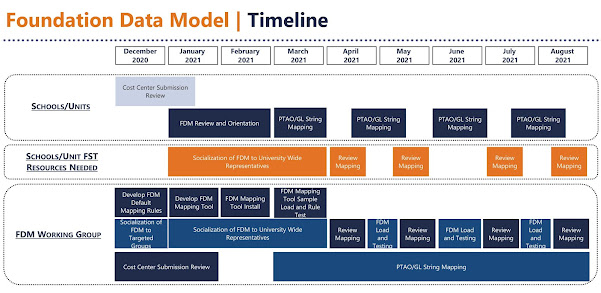That concept, of how current orgs will correlate to future cost centers, brings us to the overarching process of FDM mapping. A mapping tool is currently still under development, and it will be used by the FST team to help determine how the current COA will map to the future FDM. The mapping process will be an iterative collaboration between designated representatives in the schools and units and the project team. After the project team receives CC information from reps, they’ll determine the FDM mapping defaults to use when general ledger (GL) strings are run through the mapping tool.
Some defaults are easier to set, for example Fund Source in Oracle becomes Fund in Workday Financials. Others, such as when a current org will be broken into multiple cost centers, are more complex to handle with defaults. After the mapping is done using the defaults, that’s when partners in the schools and units will have something to look at and provide feedback about. Additional worktags are also part of the mapping process, and schools/units will determine what they want to work on mapping and when in the cycle they do so.
Here’s a basic description of the steps in the process with a visualization below (click to enlarge):
- Mapping: Data for GL strings with balances is mapped using the defaults, and a report is generated in University Business Intelligence (UBI) for school/unit review.
- Review: A designated rep from the school/unit pulls the UBI report to share with colleagues who will participate in reviewing and providing mapping adjustments. Areas will have 2-3 weeks to review and gather adjustments.
- Refinement: Consolidated adjustments will be returned to the project team, reviewed, and used to update the mapping rules. The project team will work on updates for roughly 2 weeks between review cycles.
- Repeat: Mapping will be done again using the refined mapping rules, which initiates another round of review and adjustments.
This cyclical mapping process begins in the next few weeks and continues through March 2022, with schools/units having ample opportunities to refine what their future FDM setup will look like. No further changes will be made between next March and Workday Financials go-live on July 1, 2022.
Next steps school and unit partners:
- Consider Cost Centers: Think about cost center structures already submitted and how that will map from the current COA to the FDM. The FST team will get in touch in the next few weeks to understand what defaults make sense for the org-to-cost center mapping.
- Select a Main Contact: Determine who essentially will manage the mapping exercises for the area. This person will pull the info from UBI, distribute for review, gather adjustments, and return the consolidated info to the FST team.
- Determine Process: Identify the collaborators in the area (an appropriate number based on size) and how the process will flow during review cycles.
Schools and units will get additional instructions and materials as the mapping exercise process begins in earnest. When the FDM mapping tool and UBI reports are finalized, the project team will share those with stakeholders.
For more info on the expected FDM timeline, see below (click on image to enlarge).




No comments:
Post a Comment